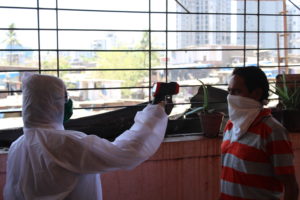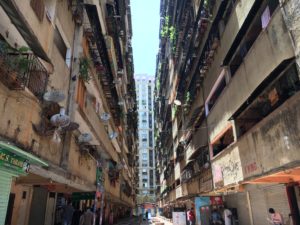A day in the life of a Community Health Visitor

A community health visitor in Kherwadi, Mumbai, measuring temperature of a resident (MIG photos/Varsha Singh)
While doctors and nurses get into the act once a Covid-19 patient is admitted to a hospital, there are hundreds of healthcare workers at the forefront, working with the communities for early detection of Covid-19 positive patients as well as to prevent the spread of the illness.
These days, the government colony locality in Kherwadi, a lower middle class cluster at Bandra East in Mumbai, is noticeably less crowded than before the pandemic struck. However, there are still hundreds of people out on the streets and narrow lanes that define not only Kherwadi, but almost all the slums and slum redevelopment areas (SRAs) in the metropolis.
It is around 10:00 am and the people are roaming around in the streets, carrying on with their usual activities – purchasing groceries, going to a clinic to see a doctor or simply standing outside their homes and talking to neighbours. At one corner of a street, a few middle aged men continue playing cards, even while a police van moves around asking people to go and stay indoors and in public spaces wear a mask as well as maintain social distancing. The men playing cards pause for the police to move and then resume their game.
Though most here understand the importance of the warnings given by the police, but there is little they can do about it in practical terms and maybe that’s why the police van simply moves on, instead of waiting to be sure that everyone follows their instructions. Indeed, social distancing for these people is a luxury as each home here is one basic room that often accommodates as many as eight persons. Dominating the slum area are two tall blocks of slum redevelopment projects, each with 14 storeys and stretching at least 200m in length, that serve as home to thousands of daily wagers. The streets in the area are piled with garbage and an open plot of land opposite the blocks is cluttered with old unused two and three wheelers.

The ill-designed and badly constructed SRA projects in Mumbai, like this one in Kherwadi, Bandra (East), serve as ideal hosts for various infectious diseases
It is areas like these that are focus of intervention by the Bombay Municipal Corporation (BMC) as part of its drive to ensure prevention and spread of coronavirus. The municipal authorities realise that if the illness does spread around here, it would be impossible to prevent it from engulfing the entire area. Hence, teams of first-level intervention of healthcare workers regularly visit these areas to check on the well-being of the residents here, especially those above 40 years of age who are believed to be at a higher risk of contracting the illness, due to their pre-existing diseases.
Swati Pandey is one such frontline healthcare worker. A community health visitor with BMC, she visits slum areas all over Mumbai for routine check-up. Her daily routine starts from 8:00 am when an ambulance picks her up and drops her at her designated intervention area for the day. There she gears up with the PPE kits provided to the healthcare workers and she starts her rounds, going from door to door.
Swati is accompanied by two other healthcare workers from Doctors For You (DFY), an NGO that brings together doctors, nurses and other healthcare professionals and is active in several states of the country. Each healthcare worker has their task assigned and they work in perfect synchronisation. While one of them keep the track record of people and homes they visit, another checks the temperature with a digital thermometer and the third one measures blood pressure with a digital meter again. They also advise people regularly on how they should protect themselves and contact them in case of any illness not just in their home but also in their neighbourhood.
Manisha Pritam works with DFY and accompanies the CHVs on their rounds. “We go from house to house in areas that have been identified by the BMC as high risk and we monitor temperature and blood pressure of each person in the area. The CHVs already have the entire data of the locality so we do the check-ups and report to them.” Pritam tells Media India Group.
Their work doesn’t stop there. They create WhatsApp groups to keep in touch with people of the same locality. It also helps them as people can report illnesses immediately.
These interventions are not only preventive but they also help in identifying Covid positive cases. Each CHV and volunteer of NGOs has come across such cases since the pandemic began. They say that the municipal authorities have laid down a clear protocol to be followed in such a case
“On two occasions we have had cases where patient has succumbed because of breathing problems but had not been tested for Covid. In both the cases we asked for a test of the entire family and the neighbours. The family is considered as high risk while neighbours are low risk. We call them on a daily basis at least for a week to be sure that they are not ill. During our random checks even if we come across anyone with high fever we report the case immediately to our superiors who take immediate action,” Swati Pandey tells Media India Group.
Pandey says that she has been visiting Covid hotspots in Mumbai and has helped over 500 families keep themselves safe. Though the CHVs and the NGOs associated with them stay below the radar and are hardly talked about, they play the vital role of being the first wall of defence against the pandemic keeping the most vulnerable people safe.









